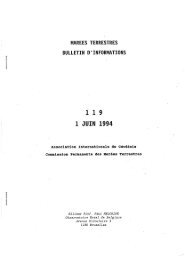marees terrestres bulletin d'informations - Université de la Polynésie ...
marees terrestres bulletin d'informations - Université de la Polynésie ...
marees terrestres bulletin d'informations - Université de la Polynésie ...
You also want an ePaper? Increase the reach of your titles
YUMPU automatically turns print PDFs into web optimized ePapers that Google loves.
1. Introduction<br />
The estimation of atmospheric attraction and loading effects are necessary for<br />
continuous and precise gravity observations, e.g., with superconducting<br />
gravimeters (SG), because gravity variations induced by shifts of air masses<br />
cover geodynamic signals of interest. Therefore, this atmospheric impact should<br />
be mo<strong>de</strong>led as well as possible and be removed from the gravity observations.<br />
A still wi<strong>de</strong>ly used atmospheric reduction is based upon an admittance factor<br />
adjusted by least square fitting between barometric pressure and SG data from<br />
an observation site. By using this method, however, only effects which are<br />
corre<strong>la</strong>ted with local pressure are taken into account and effects uncorre<strong>la</strong>ted are<br />
not consi<strong>de</strong>red.<br />
During the recent past, several attempts were ma<strong>de</strong> (e.g. Merriam, 1992; Sun et<br />
al. 1995; Boy et al., 1998, 2002; Kroner & Jentsch, 1999; Guo et al., 2004) to<br />
improve reductions by means of Green’s functions (Farrell, 1972) or using an<br />
empirical frequency-<strong>de</strong>pen<strong>de</strong>nt method (Warburton & Goodkind, 1977; Crossley<br />
et.al., 1995; Neumeyer, 1995).<br />
Merriam (1992) calcu<strong>la</strong>ted atmospheric Green’s functions (attraction and<br />
<strong>de</strong>formation), which are based on the i<strong>de</strong>al gas <strong>la</strong>w, the hydrostatic assumption,<br />
and a temperature mo<strong>de</strong>l of the COSPAR (Committee on Space Research)<br />
atmosphere. These are computed over a thin column from a height from 0 to 60<br />
km. The attraction and loading effect can be computed from these functions and<br />
surface barometric pressure data for the whole Earth. As here only surface<br />
pressure is consi<strong>de</strong>red, surface pressure in<strong>de</strong>pen<strong>de</strong>nt air mass movements are<br />
not taken into account.<br />
Neumeyer et al. (2004) computed a physical reduction using three-dimensional<br />
(3D) meteorological mo<strong>de</strong>l data from the European Center for Medium-Range<br />
Weather Forecasts (ECMWF). The attraction effect was calcu<strong>la</strong>ted up to 1.5°<br />
distance from the SG station and for the <strong>de</strong>formation part using Green’s function<br />
a distance up to 10° was consi<strong>de</strong>red. The amplitu<strong>de</strong> of the attraction part which<br />
does not corre<strong>la</strong>te with barometric pressure observed at the Earth’s surface was<br />
about 2.0 µGal (Neumeyer et al., 2006).<br />
The present investigation is based on the studies by Neumeyer et al. (2004,<br />
2006) and the object of this paper is to <strong>de</strong>rive an optimized atmospheric<br />
reduction suitable for ongoing research re<strong>la</strong>ted to gravity changes of several days<br />
and longer (e.g. re<strong>la</strong>ted po<strong>la</strong>r motion or non-tidal ocean loading etc.). Thus, in<br />
this study the focus is atmospheric variations with spatial scales of tens of<br />
kilometers to global. Reductions for atmospheric effects are a means to an end,<br />
because gravity data interpretation begins after the atmospheric reduction. In<br />
this paper, we <strong>de</strong>termine how <strong>la</strong>rge the zone needs to be for the computation of<br />
the attraction effect using 3D meteorological data and from which distance it is<br />
sufficient to use surface data and a standard atmosphere. We use spectral and<br />
tidal analyses to investigate and quantify the differences between the various<br />
reduction methods.<br />
2. Data and method<br />
2-1 The ECMWF data



